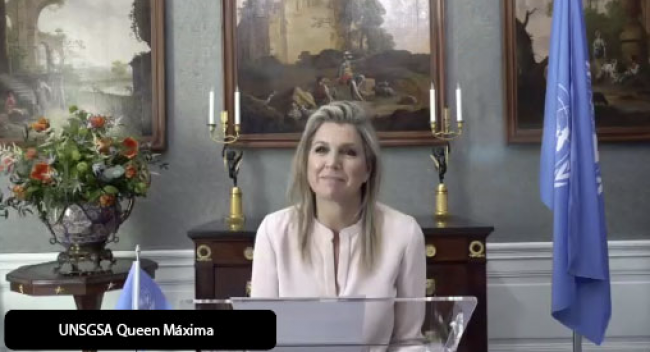
H.M. Queen Máxima of the Netherlands, the United Nations Secretary-General’s Special Advocate for Inclusive Finance for Development (UNSGSA), provided this virtual keynote address for the Sustainable Banking and Finance Network 7th Global Meeting on 26 April 2022. The UNSGSA encouraged SBFN members to advance on an inclusive green finance agenda with a focus on the individual and household level.
---
Ladies and gentlemen,
It is an honor to be here today. Thank you, Managing Director Diop, for your kind introduction.
In this time of converging global challenges, the work of the Sustainable Banking and Finance Network has never been more important.
The Covid pandemic has thrust 100 million new people into extreme poverty—undoing years of progress. Shocks like these can affect all of our lives—but especially those of the poor and the most vulnerable.
In the same way, climate change is threatening livelihoods, food security and wellbeing worldwide—with disproportionate effects on women, and again, the most vulnerable.
And the rippling effects of conflict and instability are stretching our collective efforts to respond, at a time when we need to work together the most.
Over the past ten years, this Network has shown how collaboration can strengthen our response.
Developing and sharing best practice, creating policy frameworks, and hands-on technical assistance—this is how we build a financial sector better able to withstand shocks, and to support a planet positive future.
Because of this, the Network’s reach has grown impressively from its 10 founding members in 2012, to 71 institutions today, representing (62) countries, and 86% of banking assets in emerging markets. But an essential part of our work remains to be done.
1.5 billion people are still left out of the financial system, including one billion women.
To date, much of our work has focused on the macro level.
We know, however, that it is at the micro level—of underserved households and small businesses—where people face the greatest risks, with the fewest tools to manage them. And their fortunes will determine our collective success.
So let us embrace this anniversary as an opportunity to address their needs.
As the SBFN’s International Development Association task force has recognized, financial inclusion is key to deepening financial markets, and managing ESG opportunities and risks.
Financial inclusion offers people on low incomes a chance to build resilience in the face of climate-related shocks, and to support recovery and adaptation when they occur.
In Malawi and Ghana, for example, we see clear evidence that when farmers gain access to formal savings, or instruments like weather insurance, not only are they covered against climate shocks, but they are also able to spend more on inputs, cultivate more land, and hire more people, leading to increased production.
In addition to resilience building and adaptation, there are trillions of dollars of green investment opportunities in emerging markets—from green affordable housing to climate-smart agriculture, and renewable energy.
These opportunities offer new hope, at a time when hope can sometimes be quite hard to find.
But how can we more effectively help households and small businesses access these opportunities, in ways that help them and help drive the low-carbon energy transition?
On the supply side, this means going beyond the work of traditional banks or capital markets.
Microfinance institutions, cooperatives, and fintech players should play an increasingly important role.
There are many examples of successful innovation. In Mexico, Infonavit has provided green low-income housing finance at scale for a decade. In East and West Africa, pay-as-you go off-grid energy models have given 360 million people access to affordable solar lighting.
So, we have really good stories.
Technical assistance, financial support, and well-targeted subsidies can help build this supply side response and scale up those interventions that offer the most impact for the underserved.
That was the supply side. And what of the demand side?
One big part of the solution is to help people access finance in ways that take account of how they work, live, and use technology.
Prioritizing digital and financial literacy can give the under-served the confidence and skills they need to access emerging green finance solutions.
In Mali and Uganda, for example, Oko Finance offers index-based insurance to smallholder farmers through their mobile phone, using affordable and accessible USSD technology.
So therefore, no smartphone or internet is needed, and services are offered in local languages—with an emphasis on clearly explaining products and service terms.
In closing, I would like to suggest a call for action.
For policymakers, to place financial inclusion at the core of their sustainability frameworks, ensuring households and small businesses are not left behind in broader system-wide efforts.
For financial institutions, to innovate and scale up instruments like climate-risk insurance and savings products, and to increase lending to small-scale green initiatives.
And for donors and technical partners, to do more research on how households and small businesses cope with climate shocks, and access green opportunities. This will help build the data and evidence needed to improve policy design.
Above all, let us recognize this fundamental reality: that there is no stability without inclusion, and no sustainable finance without inclusive finance.
Thank you.